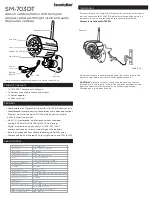
CD42 Pipeline Pig Location & Tracking System
Page 52
Chapter 5 - The Antenna
General Purpose Antenna
The CD42-GP is the General Purpose antenna of the CD42 system. It has several aspects that make it
the antenna of choice in the field.
The CD42-GP rejects, to a great extent, the earth‟s magnetic field. What this means to
the operator is that he can, for the first time with any pig tracking and locating system,
walk at a normal pace and search for transmitter pulses simultaneously.
50+ foot reception range in open air.
25+ foot reception range in a pipeline.
The CD42-GP is watertight, able to withstand being submerged to a depth of several feet.
Very convenient for swamp or under-river duties.
Integral shoulder strap included.
The CD42-T1 transmitter emits magnetic flux signals much like an electromagnet. The orientation of
the CD42-GP antenna to the CD42-T1 transmitter affects the reception of the signal in a somewhat
complex manner. Generally speaking, the coupling of the CD42-T1 transmitter to the CD42-GP
antenna is best when they are held perfectly parallel to each other. This causes the magnetic flux lines
to pass completely through the CD42-GP antenna longitudinally, generating the highest voltage and the
largest signal on the CD42-R display. This is known as the Pattern of Inductive Coupling, or PIC.
This aspect of the PIC phenomena is most useful when the operator is walking the pipeline searching
for a stuck pig equipped with a transmitter. In these instances the operator usually walks above or
beside the pipeline, where there may or may not be ground cover, and holding the antenna parallel to
the pipeline is the most convenient. The closer the operator is to the transmitter, the higher the signal
strength displayed on the CD42-R .
When the CD42-GP antenna is held perfectly perpendicular to the CD42-T1 transmitter, the magnetic
flux lines pass through the antenna in a perpendicular fashion, generating the least amount of voltage.
Consequently, these magnetic transmissions show up as little or no signal strength on the display of the
CD42-R. As the receiving antenna is swept back and forth through the magnetic flux lines, while
continually being held perpendicular to the transmitter, the signal strength will increase slightly as the
distance from the transmitter becomes greater and then begin to fade again. This is because some
slightly greater amount of magnetic flux lines are traveling down the length of the antenna. This aspect
of the PIC phenomena is most useful when
nulling
and the precise location of the transmitter is desired.











































